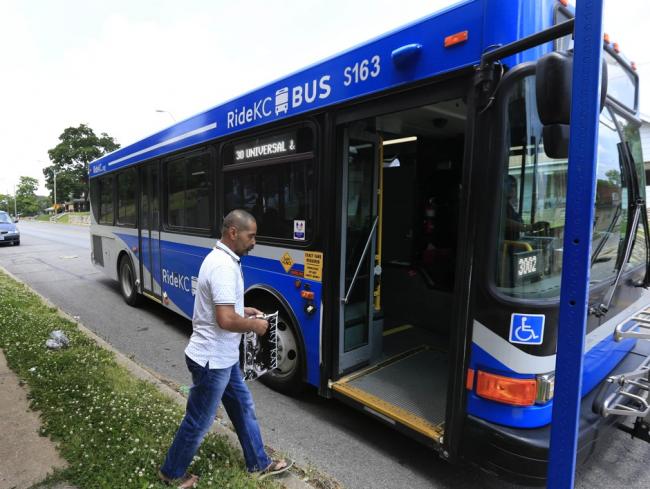Articles Menu

The Missouri city is the first major one in the U.S. to offer no-cost public transportation. Will a boost in subsidized mobility pay off with economic benefits?
Kansas City, Missouri, made national headlines last week when its city council voted to make bus rides free, becoming the first major metropolis in the U.S. to provide no-fare public transit starting next year. The cost to the city will be $9 million, which is roughly what the Kansas City Area Transportation Authority brings in annually from the current $1.50 bus fares and $50 monthly passes.
The hope among lawmakers and transportation officials is that the city will recoup that expense, and more. By increasing mobility overall, KC is looking to boost economic activity. And proponents of the plan say that helping marginalized communities move around more easily will translate into deeper benefits.
The reaction to the news was a mix of fevered enthusiasm and wonkish reserve. Progressive politicians in Nashville, New York City, Portland, and other U.S. cities hailed the decision as an equity victory—especially in a town where a single street historically served as an impenetrable dividing line between black and white, rich and poor.
Others struck a more skeptical note: A number of news articles pointed out that free fares aren’t a panacea for ailing ridership or service gaps, citing a 2019 report from the think tank TransitCenter that warned as much. “This will reduce barriers to access to people, which is great, but very few routes run frequently,” TransitCenter spokesman Ben Fried told Streetsblog. “If you reduce barriers to access to a system that doesn’t do a great job connecting people where they need to go, it’s only helping people so much.”
In practice, free transit fares has led to varied outcomes. Several smaller U.S. cities currently offer them, including ski centers such as Vail, Colorado, and university towns such as Chapel Hill, North Carolina. Typically, they’ve experienced strong ridership growth. The largest U.S. city to have experimented with it was Austin, Texas. But when the Texas capital briefly went fare-free from 1989 to 1990, it saw “dramatic rates of vandalism, graffiti, and rowdiness” and escalating “vehicle maintenance and security costs” due to repairs from passenger abuse, according to a 2002 review of the program.
Yet the Kansas City council’s decision was still significant. At a time when public transportation systems face greater competition from ride-hailing services and other tech-enabled tools—and with climate change placing new urgency on shifting travelers out of cars—the City of Fountains has shown an unusual willingness to experiment with new ideas, transit experts say.
Remember Bridj, the startup that thought it could connect riders with on-demand transit service along a flexible route in a 14-seat minibus? Kansas City’s transit authority partnered with that fledgling company in one of the country’s first “microtransit” pilots all the way back in 2016. The idea was to see whether such a tech-enabled service could draw transit riders in a low-density, auto-oriented area. “The way I see Bridj is that it breaks down barriers for people to use public transit,” KCATA CEO Robbie Makinen told CityLab at the time. “There are more options for people to access the whole system. It’s a robust transit system that encapsulates all types of modes.”
It didn’t work: Bridj was a colossal failure. After six months, the vans had provided fewer than 600 rides, hugely short of the 200 daily riders that leaders had hoped for. But microtransit didn’t die (though some transit experts think it should): Dozens of similar pilots have since appeared across the country, from Los Angeles to Columbus to Montgomery County, Maryland. Startups like Via are still trying to crack the code of whether microtransit can viably serve large numbers of riders. These players learned lessons from Kansas City’s willingness to see what happened when it linked up with a tech-forward transportation idea.
Kansas City’s move to make fares permanently free on its sales-tax-funded streetcar line also reflects that entrepreneurial spirit, said Bob Bennett, the city’s former chief innovation officer. “Over the last four to five years, there’s been a mindset change at the city, and that mindset change is focusing less on what the ridership and operations of transit mean and more on what the impact of that transportation is,” he said.
Take, for example, the KC streetcar. Boosters figure that the 2.2-mile downtown line has brought in more than $2 billion in property value growth since opening in 2015. Ridership has grown steadily—unusual for downtown streetcars, which are often a novelty of sorts. City residents recently voted to double the line in length.
Public transit leaders have to be creative in Missouri, considering what they’re handed as funding: In 2017, the state legislature spent a miserable $.34 per capita on transit, a tiny fraction of neighbors like Illinois ($190.42 per capita) and even Kansas ($3.78 per capita). The environment of extreme austerity worsens a host of entrenched racial gaps, advocates and researchers say.
[Top photo: Come on and take a free ride. Orlin Wagner/AP]